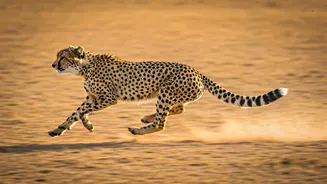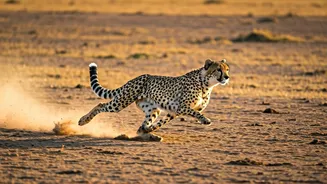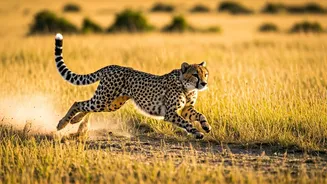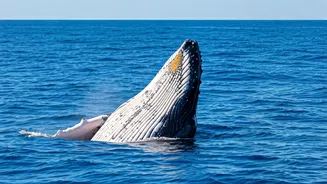Cheetah: Land's Fastest
The cheetah, an iconic symbol of speed, dominates the land with its incredible velocity. Its slender body, long legs, and flexible spine contribute to
its ability to reach astonishing speeds. Cheetahs can accelerate from 0 to 60 mph in a matter of seconds, making them one of the quickest accelerating animals in the world. Their speed is essential for survival, enabling them to hunt prey across the African savannas. These specialized adaptations have evolved to help them capture food and evade predators, which plays a major part in how they flourish. The cheetah's extraordinary speed is a result of evolutionary pressures, leading to a perfectly optimized design for chasing down swift prey.
Peregrine Falcon: Airborne Ace
The peregrine falcon holds the title of the world's fastest animal during a dive, reaching speeds that would challenge a race car. This aerial predator is known for its streamlined body and specialized feathers. When the falcon dives, its aerodynamic design minimizes air resistance, allowing it to accelerate rapidly. Its hunting strategy involves stooping down from great heights to catch prey mid-air. The falcon's remarkable aerial prowess is a perfect example of natural engineering. These birds' speed and agility demonstrate evolution's capacity to create exceptionally well-adapted organisms. The peregrine falcon's hunting technique is both spectacular and effective, showcasing its unique position in the avian world.
Sailfish: Aquatic Missile
Sailfish are marine creatures that are renowned for their incredible speeds underwater. These fish possess a large dorsal fin, which resembles a sail, and a streamlined body that is built for speed. Their powerful muscles and hydrodynamic shape enable them to cut through water effortlessly. The sailfish's speed is crucial for capturing agile prey such as mackerel and sardines, showcasing its adaptability in its ocean habitat. These aquatic predators are among the fastest fish in the ocean. The sailfish is a testament to the ocean's capacity to host amazing adaptations and speed.
Pronghorn: American Speedster
The pronghorn is often mistaken for an antelope, but it is unique to North America. It is the second-fastest land animal in the world. Pronghorns boast excellent stamina and are built to cover vast distances. Their large lungs and heart allow for efficient oxygen intake, fueling their high-speed pursuits. They have evolved over time to outrun predators such as the extinct American cheetah, displaying an amazing example of co-evolution. The pronghorn's speed gives it an advantage in harsh environments where rapid movement is essential for survival.
Frigatebird: Aerial Endurance
Frigatebirds, often called man-o'-war birds, are remarkable for their aerial endurance and speed. These seabirds possess long, slender wings that allow them to fly efficiently over long distances. They have a light bone structure and a low body weight, allowing them to soar effortlessly. Frigatebirds are known for their ability to snatch prey mid-air, relying on their agility and speed to survive. Their incredible aerial abilities are essential for hunting, gathering food, and navigating coastal waters. The frigatebird's design showcases nature's brilliance in adapting to the challenges of flight.
Black Marlin: Deep-Sea Racer
The black marlin is another champion of speed in the marine world, known for its powerful build and incredible velocity. Its streamlined body and specialized fins help it cut through water. These fish are among the largest bony fish, often exceeding 1,500 pounds, and their speed helps them to hunt efficiently in the deep ocean. Black marlin's speed is necessary for catching prey and escaping predators. The black marlin’s speed and power make it a top predator in the ocean.
Eurasian Hobby: Agile Hunter
The Eurasian hobby, a small falcon species, is known for its agility and speed. These birds are adept at catching insects and other small birds in mid-air. Their streamlined bodies and pointed wings enable quick maneuvers. Eurasian hobbies are particularly agile, often flying in areas with numerous obstacles. Their hunting style is very skilled, demonstrating how they have adapted to their surroundings. The Eurasian hobby represents the speed and grace of birds, showcasing the capabilities of nature's design in the avian world.





